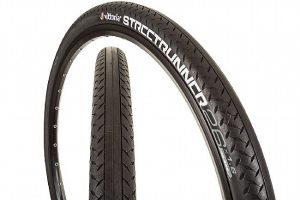Von Collins is an accomplished triathlete and endurance cyclist, and the author of four fitness and training books: Smarter Running, Your First Triathlon Guide, Fit Foods, and 30 Rut-Busting Workouts. He has been cited as a triathlon, cycling, and fitness expert by Healthline, CNET, Forbes, Eat This, Not That and other major outlets.
One of the more common questions we get from beginner triathletes is if they can use their mountain bike, commuter bike, or hybrid bike in the triathlon. The answer is yes, absolutely – especially if you are doing a sprint or perhaps even an Olympic distance.
It can be tempting when starting a new sport, to run out and buy all the awesome gear you see the professionals using. You wonder if you will be taken seriously if you are not rocking the right equipment. However, making huge purchases for something you may not take up as a serious hobby can be a costly mistake. If you have the budget to invest in an entry level road bike, take a serious look at doing so because you undoubtedly will use the road bike far beyond the triathlon. If you don’t have easy access to that kind of budget – and most of us don’t — It is best to hold back until you have done a tri or two and have discovered whether you have a passion for it.
Of course it makes sense to consider using a bike you already own, vs. going out and buying a brand new one just for your first triathlon. There is no judgment based on having the “right” cycle. All types of bikes can be found in these races, as most people are racing only for fun and exercise. Unless you are at the Half Iron or Ironman level, it is guaranteed you will not be the only rider on an average cycle. Cruisers, road bikes, and everything other type will be there. Most of us have a mountain bike stored in our garage somewhere that we could use.
The Straight Scoop: Road vs. Tri vs. Mountain and Commuter Bikes
First, the straight scoop on what you will see at most triathlons. Typically, you will see the majority of people riding either a triathlon bike or a road bike. They are quite similar in that they are both lightweight bikes built for speed and acceleration, with skinny tires and high gearing. Tri bikes are the ones with the aerobars out in front, where the rider can get in a real aggressive position (more on tri bikes here). Other than that, the only real difference between the two is slightly different frame geometry.
Depending on the race, some portion — anywhere from 10% to as many at 25% for a small, local race, will ride whatever they had in their garage — a mountain bike, comfort bike, hybrid, or commuter bike. Because of weight, gearing, and frame geometry, these bikes will never be as fast (assuming the same power from the rider) as a road or tri bike, but there are some steps you can take to get a little more speed out of them if that is important to you.
Possible Modifications for Using Your Bike in a Triathlon
If you already have a road bike or tri-style bike, you are set. No modifications needed. However, if you are riding that hybrid, crossover, comfort, commuter, or mountain bike from your garage, you may want to consider a few modification. These are by no means required, but could help you shave a few minutes off of your finishing time or made you more effective on the ride.
Street Tires or “Slicks”

Mountain bikes are made to conquer rough terrain and grip in places without solid footing. As a result, there is lots of contact between the rubber and the ground – more than you need on pavement. In a tri, it is a good idea to replace the knobby tires with a more road-ready option. Grab a tire that is smooth in order to minimize resistance on the street and maximize speed – these tires are commonly known as “slicks”. Street tires are the #1 recommended modification for anyone taking a mountain bike into a triathlon, and the good news is that doing so should cost you less than $50. All the other upgrades listed in this article can wait, or be bypassed completely by purchasing a tri-bike when you are ready to step up to the next level.
Be sure you get a tire that fits your rims, if get tubes that have the right kind of valve for your wheels (presta vs. schrader.)
Recommended: The Vittoria Street Runner (pictured) is a great all-around slick that won’t break the bank.
Clipless Pedals
High-end pedals are not a necessity, but if you want to see how fast you can race and compete, they are definitely worth considering. There is a good chance you already have some type of clipped or clipless pedals on your bike. Basic pedals are fine for casual riding, but an upgrade will make a big difference in your times. Clipless pedals provide more stroke control and allow you to get power from the entire 360 degree rotation of each pedal stroke. They are coupled with shoes that snap onto the pedal quickly and lock your feet into position. These connect the rider to the bike, making for tighter turns, better handling, and consistent pedaling. Clipless pedals are certainly a worthwhile investment once you begin the transition into a serious competitor. They are easily installed on any bike either at home or in just a few minutes at a bike shop.
You will have to make a choice on types of bike cleats, so do a little research before you commit to one style.
Seat / Saddle Replacement
Your bike seat is one part of the bike that is entirely personal preference. However, it is an opportunity to shave some weight off your ride, and also position yourself for speed versus mobility and comfort, which is how many mountain bikes come from the factory. The decision on which saddle is right for you depends entirely on what is most functional and comfortable for your rear end. Go with what works for you, as we all have different needs. The only advice in this area for using a mountain bike in a triathlon is raising the seat level to gain a higher stance. This allows better positioning for speed.

Aero Bars
Adding clip-on aero bars to your MTB handlebar is another option that you will see some racers do, but we don’t recommend it. The aero bars on a triathlon bike are designed for perfect body positioning in relation to a tri bike frame. A mountain bike has fundamentally different frame angles, and you aren’t going to change that. Some riders swear that bull-horns, or aero bars, make reductions in drag due to aerodynamics. We say that if you are going to so this far with your bike, just consider an entry-level road or tri bike.
Suspension
Adjusting the suspension on your mountain bike is a free adaptation that will help as well. Tighten your springs as much as possible or lock them in stiff if your bike is able. The flexibility of the springs helps in rough areas but hinders speed and control in a street riding scenario. You don’t need any suspension at all while racing in a triathlon. The cycling leg of a triathlon should be a smooth ride, so bypass the suspension and glide. The stiffer the bike, actually, the better when it comes to speed and getting all of your leg energy to translate to wattage and output to the pedals.
Summary
One important thing to note is that the gearing of a mountain bike is fundamentally different than that of a road or tri bike. Mountain bike gears are not meant to cruise at high road speeds – they are meant to be responsive in technically challenging conditions. Even a perfectly-outfitted mountain bike will be a couple miles-per-hour slower than the same ride on a road or tri bike.
On the other hand, using a bike that doesn’t fit will be a painful experience. Better to use a slower bike that fits, than a supposedly faster bike that you will not be comfortable on.
The fact is that you can use pretty much any bike that you want for a triathlon, with the exception of an e-bike. You still can’t use an e-bike in a triathlon, and I don’t see that changing anytime soon.
Entering a triathlon for the first time can be an exciting experience. The most important thing to remember is not everyone is there trying to win. Most entrants are only concerned with having fun and racing against their own best times, or perhaps completing their first race ever so they can cross it off their bucket list. Enjoy yourself and do not be concerned early on about having all the right gear. You always have the option of buying the professional equipment later to help your times, but at first, just relax and revel in the new adventure.








Yes, have seen it all on the road at tris. Even wicker baskets up front with flowers in them. Some folks having fun and we will cheer them on of course!
Saw a handful of riders even do the reverse… a lightweight carbon frame complete with road gearing, yet mount flat bars (as seen on MTB), because for whatever reasons it is most comfortable to them. So yes the bike you really feel happy on is better than any bike riden in misery.
Totally smoked the field in my first multi sport race, a duathlon on a $750 hybrid. Dudes on $9000 carbon tri bikes were a little pissed as I went whizzing past them. Upgraded to a road bike with aero bars the following year.